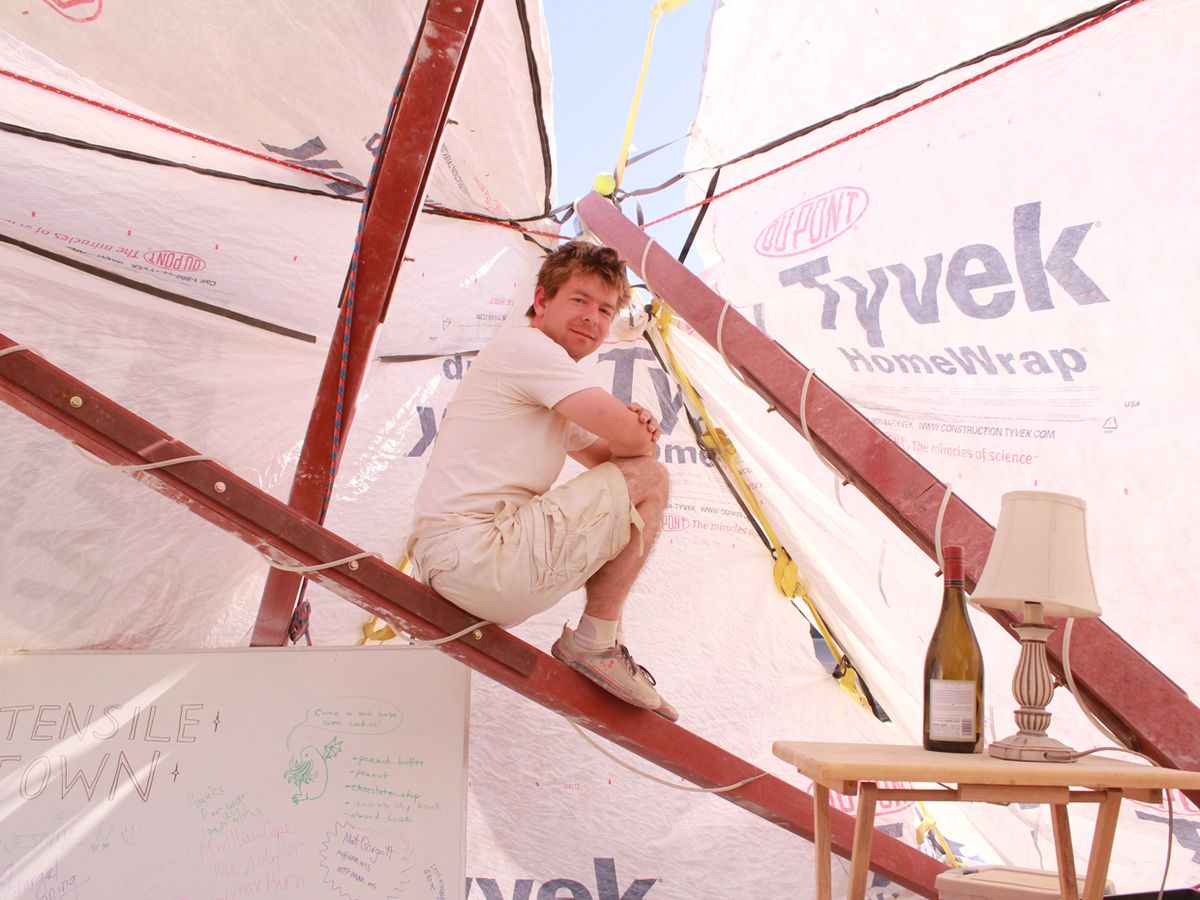Burning Man is a weeklong end-of-summer bacchanalian arts festival that promotes radical self-expression and experimental community building, held annually on the playa of Nevada’s Black Rock Desert. This year’s festival took place between 27 August and 3 September, and amid the 60 000 revelers was the Alternative Energy Zone (AEZ)—an oasis of nearly 500 engineers and engineering-minded campers.
The AEZ made its first appearance at the 2000 festival, as 50 people camping without generators. The group has grown to delight in building ecological living structures powered by sustainable energy devices. This year’s AEZ was composed of 90-plus distinct subcamps, without a fossil-fuel generator in sight. Instead the zone was awash in homemade “evapotrons” (wind- or solar-powered devices that evaporate wastewater, important in the crowded drainage-free conditions), swamp coolers (which provide air conditioning through water evaporation), heat-deflecting yurts, and wind- and solar-powered electrical microgrids. Daily tours showcased these wonders and taught people how to do for themselves.
“This is a village of doers who bring extra parts and fittings with them in case someone needs repairs,” says outgoing AEZ leader “Jolly” Roger Wilson, creative director for the Willits Kinetic Carnivale, an annual steampunk festival in Willits, Calif., who started out as an architect-turned-film industry computer modeler; he worked on such films as 1982’s Tron. “They’re good at making stuff that works. There is some very elaborate engineering here,” Wilson says. Past whimsies include a timed laser that indicated the location of a passing satellite every night, solar-powered racing vehicles, and a solar hot-dog cooker fashioned from an abandoned satellite dish.
Such undertakings let engineers stretch their knowledge, teach nonengineers basic skills, and get festival attendees thinking about their energy consumption year-round.
“It’s an entire village of power nerds—everyone has an interesting project or fascinating background,” says Shawn Brenneman, a Google software engineer in Mountain View, Calif., who turns “impractical tensegrity structures”—made of cables and struts that rely on tensile forces to stay up—into artistic living spaces in his camp, Tensile Town. “Even people who aren’t engineers by trade here build hard things as hobbies. It’s a way to try something new in a space of people who are all into that.”
Take the Cult of Levitating Plywood, a time-honored AEZ camp so named for suspending a 14-square-meter plywood second story inside a 7.3-meter-diameter geodesic dome—a project that evolved over several years from computer models made during the creators’ MIT undergrad days. The camp also boasts a 400-watt solar-power grid that charges batteries and also powers a snow-cone machine, a rice cooker, a refrigerator, several homemade swamp coolers, and decorative blinking LED lights.
“They may not all be engineers by profession, but pretty much everyone in AEZ is an engineer by mind-set,” says Christine Robson, who just completed a computer science doctorate at University of California, Berkeley. She and fiancé Josh Weaver, a Google electrical engineer and computer scientist, are among the Cult of Levitating Plywood’s founding members. “A lot of engineers end up working in just one field, so this is a way to stretch our engineering breadth and do projects outside of our comfort zones,” Robson says.
The impact can extend far beyond the festival itself. Involvement in the AEZ prompted Geoff Horne, a Silicon Valley computer scientist and a former leader of the AEZ, to rewire his home for solar energy. David “Keyman” Kulka, an audio engineer who’s president of Studio Electronics in Burbank, Calif., and helped construct the AEZ’s 0.125-W FM radio station, says the experience has led him to embrace teamwork. “I tend to take care of myself, not offer or ask for help with things, and sort of live in a bubble,” he says. “This sort of attitude is not ideal on the playa, so I’ve learned to open up, ask for and offer help.”
Even nonengineers get into the spirit. Wilson’s best friend, Richard “Cousin Dickey” Weinkle, a retired insurance agent, learned how to wire his trailer for solar energy after Wilson caught him with a generator. “I’m the poster child for a nonengineer being able to learn this stuff,” Weinkle says. “Most engineers aren’t people persons. The folks at AEZ are effusive, and they try to help you with your projects. Being here made me pay attention to how I was living my life. My home now has solar power, water collection, and a vegetable garden.”
Weinkle and Wilson are going so far as to begin planning a self-sustaining community in Willits that will be engaged in building, electronics, farming, and the arts. “I want to take some of the qualities that I find at AEZ and Burning Man and have them year-round,” says Wilson.
About the Author
Susan Karlin regularly writes about the intersection of pop culture and technology for IEEE Spectrum. In “Pocket Studios” she looked at how professional filmmakers and musicians are using smartphones to record their productions.
